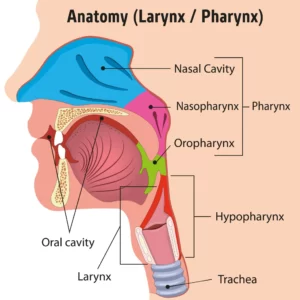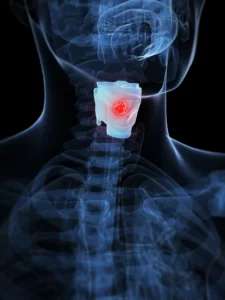Throat Cancer
Home | Voice, Throat & Swallowing | Throat Cancer
What Is The Throat?
The throat is important in eating, breathing and speaking. To accomplish these different tasks, the throat is divided into two main parts. The pharynx is the avenue through which food travels to the stomach and air is sent to the lungs. The larynx (sometimes called a voice box) allows us to speak and also protects the airway from food when we eat.
What Is Throat Cancer?
 Throat cancer, a type of head and neck cancer, can be found in the pharynx or larynx. This article will predominantly focus on cancer of the pharynx, rather than cancer of the larynx.
Throat cancer, a type of head and neck cancer, can be found in the pharynx or larynx. This article will predominantly focus on cancer of the pharynx, rather than cancer of the larynx.
In general, cancer occurs in the body at the cellular level, caused by a disruption in cellular activity when normal cell reproduce uncontrollably or don’t die as they should.
Throat cancer mostly originates in squamous cells, which are thin, flat cells that line the pharynx and larynx.
This condition can affect either the pharynx or larynx and there are a variety of different types, based on where the cancer is found. Squamous cell cancer of the throat can spread to other areas of the body including the lungs, bone and liver.
The pharynx is a 5-inch hollow tube that starts behind your nose and mouth, and ends at the top of the trachea (also known as the “wind pipe”). Cancer in any part of the pharynx is known as pharyngeal cancer.
There are three parts to the pharynx that can further classify the type of pharyngeal cancer a person has. Going from top to bottom, these are the nasopharynx (part of the pharynx behind your nose, where nasopharyngeal cancers occur), the oropharynx (part of the pharynx behind your mouth, where oropharyngeal cancers can be found), and the hypopharynx (the bottom part of the pharynx, where people can have hypopharyngeal cancers).
Who Is At Risk For Throat Cancer?
Tobacco use (in any form) and excessive alcohol consumption are the two greatest risk factors for developing this condition. Infection with the human papillomavirus (HPV) is increasingly linked to throat cancer as well, especially in younger people. Poor diet and oral hygiene, vitamin deficiency and Epstein-Barr virus (EBV) are also risk factors.
What Are The Symptoms Of Throat Cancer?

Symptoms for throat cancer can vary, depending on where the cancer is found. They may include:
- A sore throat that doesn’t go away
- Pain or difficulty swallowing
- Persistent ear pain
- A lump in the neck or throat
- Hoarseness or other changes in the voice
- Coughing up blood
- Unexplained weight loss
- Constant bad breath
- A stiff jaw
How Is Throat Cancer Diagnosed?
Diagnosis of throat cancer typically begins with a physical exam conducted by your doctor to check for any signs of abnormality, such as a sore or lump in your mouth or swollen lymph nodes in your neck. Flexible nasoendoscopy will also be performed, which is a procedure using a small camera and light. The endoscope is inserted through your nose and travels down the throat, allowing closer visualization
If an abnormality is spotted, a biopsy may be recommended to confirm the presence of cancer. If throat cancer is diagnosed, you will likely need imaging tests (usually CT and PET scans) to determine whether the throat cancer has spread to other areas of the body.
How Is Throat Cancer Treated?
The treatment depends on the type of cancer you have, and whether it has spread to other parts of your body, such as your mouth or lymph nodes. Common treatments include radiation to kill the cancer cells, or surgery to remove the affected area. Removal of part or all of the larynx or pharynx can affect a person’s ability to speak. A person recovering from throat cancer surgery may need to learn how to speak in new ways, either using breathing techniques or voice aids.
If the throat cancer has spread to other areas of the body, more extensive treatment might be required. Your doctor might also recommend the following additional treatments to give your body the best chance at eliminating the cancer completely:
Radiation therapy:
This uses high-energy rays to kill cancer cells and prevent new cancer cells from growing. It is highly recommended that people who are being treated with radiation for throat cancer quit smoking before receiving treatment in order to maximize the effectiveness of radiation therapy.
Chemotherapy:
This uses anticancer drugs to kill cancer cells in the body. Chemotherapy is often recommended for advanced stage (3 & 4) throat cancer, and is usually prescribed in combination with radiation. Sometimes, chemotherapy is given prior to surgery in order to shrink the tumor.
Targeted therapy:
This therapy uses drugs to kill cancer cells without harming normal cells. It may be recommended for advanced stage throat cancers. Currently, targeted therapy is used primarily to treat laryngeal, oropharyngeal, and hypopharyngeal cancers.
Voice Conditions
Throat / Swallowing Conditions
Procedures & Treatments
- Tracheostomy
- Microlaryngoscopy with Phonosurgery
- Flexible Nasoendoscopy
- Direct Laryngoscopy
- Removal of ingested foreign body
- Tonsillectomy

